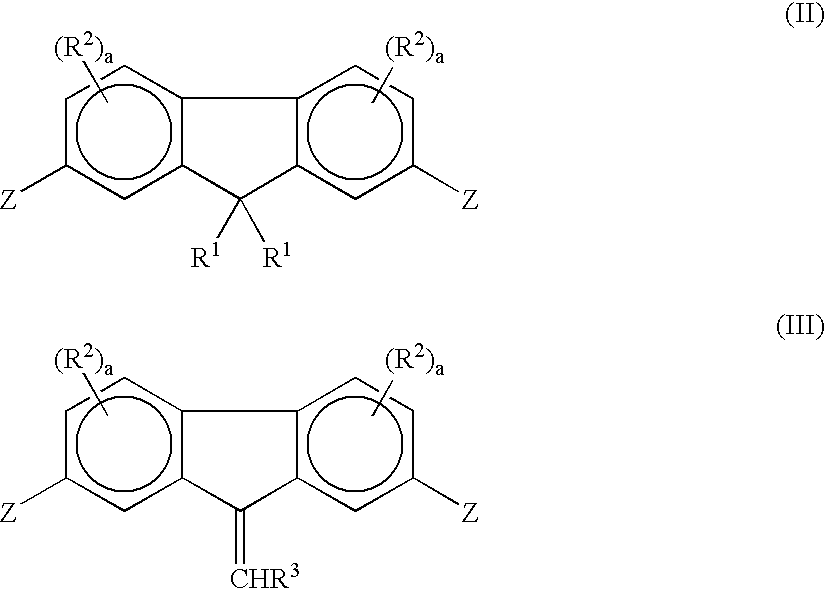Fluorene-containing polymers and compounds useful in the preparation thereof
a technology of fluorene and polymer, which is applied in the field of new-generation, 7-dihalofluorene, can solve the problems of significant crosslinking and mislinking reactions during polymerization, non-regioselective coupling and a significant number of polynuclear structures, and low molecular weight oligomers and polymers with low degrees of polymerization. , to achieve the effect of high glass transition temperature, good solubility
- Summary
- Abstract
- Description
- Claims
- Application Information
AI Technical Summary
Benefits of technology
Problems solved by technology
Method used
Image
Examples
example 1
2,7′-Dichloro-9,9-di(2-ethylbexyl)fluorene
[0091]To a stirred mixture of 2,7-dichlorofluorene (43 g, 0.183 mole) and 120 mL of dimethylsulfoxide (DMSO) under nitrogen is added benzyltriethylammonium chloride (2.3 g, 0.01 mole) and 60 mL of a 50 weight percent aqueous solution of sodium hydroxide. 2-Ethylhexyl bromide (85 g, 0.44 mole) is added and the mixture is agitated well for 2 hours. The reaction is exothermic, the temperature reaching 80° C. within 5 minutes after the addition of 2-ethylhexyl bromide and then falling off to 30° C. over the 2-hour reaction time. Analysis of an aliquot by high pressure liquid chromatography (HPLC) shows the complete disappearance of 2,7-dichlorofluorene and the formation of new product. Water (200 mL), and diethyl ether (250 mL) are added to the reaction mixture, stirred for 15 minutes and the layers are separated. The organic layer is washed with a saturated aqueous NaCl solution, water, dried (MgSO4) and evaporated to remove ether. Fractional v...
example 2
9,9-Di-n-butyl-2,7-dibromofluorene
[0092]2,7-Dibromofluorene (32.4 g, 0.1 mole), n-butyl bromide (75 g, 0.55 mole), tetra-n-butylammonium chloride (1.5 g) and 50 percent aqueous NaOH solution are stirred vigorously at 80° C. for 1 hour. The reaction mixture is allowed to cool to room temperature and extracted with ether. The ether extracts are washed with water and dried over anhydrous magnesium sulfate. Removal of solvent gives a yellow solid which is recrystallized from 400 mL of ethanol to provide 9,9-di-n-butyl-2,7-dibromofluorene as colorless crystals (42 g, 96 percent yield), melting point 120.5° C. to 121.5° C. HPLC analysis shows that the product has a purity of 99.5 percent and the proton and carbon-13 NMR are consistent with the title structure.
example 3
2,7-Dibromo-9,9-((2-methoxycarbonyl)ethyl)fluorene
[0093]To a 500 mL, three-necked, round-bottomed flask equipped with a condenser, magnetic stirring bar, stopper and a rubber septum is added 2,7-dibromofluorene (70.0 g, 0.216 mole) and methyl acrylate (166.0 g, 1.9 moles). To that stirring mixture is added dropwise (via syringe) benzyltrimethylammonium methoxide (3.3 mL, 40 weight percent solution). An exotherm is noted after addition of a few drops; temperature rose to 60° C. After the addition is completed, the reaction is stirred for an additional 15 minutes.
[0094]Excess methyl acrylate is distilled off under reduced pressure. The crude product solidifies after cooling to room temperature and is washed with hexane, then filtered. The crude solid is recrystallized from methanol to afford white crystals (79.0 g, 90 percent yield).
PUM
| Property | Measurement | Unit |
|---|---|---|
| polydispersity | aaaaa | aaaaa |
| mole ratio | aaaaa | aaaaa |
| temperature | aaaaa | aaaaa |
Abstract
Description
Claims
Application Information
 Login to View More
Login to View More - R&D
- Intellectual Property
- Life Sciences
- Materials
- Tech Scout
- Unparalleled Data Quality
- Higher Quality Content
- 60% Fewer Hallucinations
Browse by: Latest US Patents, China's latest patents, Technical Efficacy Thesaurus, Application Domain, Technology Topic, Popular Technical Reports.
© 2025 PatSnap. All rights reserved.Legal|Privacy policy|Modern Slavery Act Transparency Statement|Sitemap|About US| Contact US: help@patsnap.com



